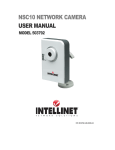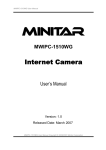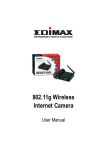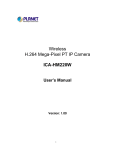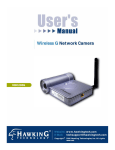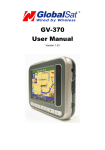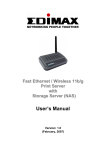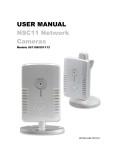Download English manual
Transcript
IP camera CAM78IP 300K wireless LAN IP camera IP camera Disclaimer • We spared no efforts to make sure that the information in this manual is correct and complete. However no liability is accepted for any errors or omissions. Gembird Electronics reserves the right to change the specifications of the hardware and software described in this manual without prior notice. • No part of this manual may be reproduced, transmitted or translated in any language in any form, by any means, without the prior written permission of Gembird Electronics Ltd. • Gembird Electronics makes no warranties for damages resulting from corrupted or lost data due to a mistaken operation or malfunction of the product, the software, personal computers or peripheral devices. Gembird® is a registered trademark of GMB Tech (Holland) bv. Other names or products not mentioned above may be registered trademarks or trademarks of their respective owners. Copyright © 2007 Gembird Electronics Ltd. All rights reserved. IP camera CAM78IP User manual Introduction Thank you for buying the Gembird® 300K wireless LAN IP camera! This manual will help you install and use it properly. This Internet Camera sends live video through 10/100Mbps wired network to a web browser or camera viewer across Internet anywhere in the world! This compact, self-contained unit lets you keep an eye on your home, your kids, and your workplace—whatever’s important to you. How does the Camera do all of this? Unlike standard “web cams” that require an attached PC, the Internet Camera can connect directly to a network. The MJPEG video compression produces a high quality, high-frame rate, 640 x 480 video streams. This Internet Camera provides a wide angle lens can let you see more of view. You ca pan and tilt by manual or use Auto-Pan-Tilt function by automation. The included Camera Viewer utility lets you record the video to your local hard drive, “live” or on a predetermined schedule. IP camera Features • Remote controlled via wireless Ethernet network or via wired LAN • Accessible via HTTP protocol, sends recordings by E-mail (SMTP), supports static IP, DHCP, PPPoE, DDNS, NTP (Network Time) protocols • Supports pan/tilt rotation control • Supports video recording using MJPEG coding • Supports motion detection function • Resolution: 160x120, 320x240 and 640x480 pixels, 1/4" 24 bit Specifications color CMOS sensor • Video frame rate: 10fps for 640x480, 20fps for others • Gain control, exposure, white balance: automatic • Focal length: 4.8 mm • Aperture: F=1.8 • Image quality: Lowest, Low, Normal, High, Highest • Wireless standard: IEEE 802.11b/g • Supports HTTP, FTP, SMTP, static IP, DHCP, PPPoE, DDNS, NTP protocols • LED Indicators: LAN LED (green), WLAN LED (amber), Power LED (blue) • AC-DC power adaptor: input 200-240VAC 50/60Hz 0.3A; output 12V 1.0A • Dimensions of camera: 119x78x50mm • Net weight of camera: 183g IP camera Package contents • IP camera • Power adapter • Camera stand • LAN patch cord • User manual • Software CD • Antenna System requirements • OS system: Windows 98/ME/2000/XP+SP2/Server 2003/Vista • MS Internet Explorer: v.6.0.29 or above • CPU: Intel Pentium III 750MHz above or Intel Celeron 1GHz above • Memory size: 128MB (256MB recommended) • DirectX 9.0 or above installed IP camera Hardware Installation LED and Focusing The Camera head and its focus ring allow you to modify the aim and focus of the Camera. To adjust the Camera’s focus, rotate the dark focus ring. There are four LEDs indicating the camera status and networking status. Ÿ Power When the camera is power on, the LED will light and can not be turned off. Ÿ LAN When the Internet Camera is linking to wired network, the LED is lighting. The LED is flashing when video is transmitted or received through wired network. Ÿ WLAN When the Internet Camera is linking to wireless network, the LED is lighting. The LED is flashing when video is transmitted or received through wireless network. IP camera Wireless SMA Connector (Wireless Model Only) LED Green: LAN Activity LED Amber: WLAN Activity Focus LED Blue: Power On Ring IP camera Camera Ports The Camera features three ports and a Reset button. Ÿ Power The Power port is where you can connect the power adapter. Ÿ LAN The LAN port is where you can connect the Ethernet network cable. Ÿ WLAN (Antenna Connector) This round connection is standard Reverse SMA connector where any antennas with Reverse SMA connector can connect to the Internet Camera.. Ÿ Reset 1. If problems occur with your Internet Camera, press the reset button with a pencil tip (for less than 2 seconds) and the Internet Camera will re-boot itself, keeping your original configurations. 2. If problems persist or you experience extreme problems or you forgot your password, press the reset button for longer than 5 seconds and the Internet Camera will reset itself to the factory IP camera default settings (warning: your original configurations will be replaced with the factory default settings). Power Jack LAN Port Reset Button IP camera Installation Procedure 1. Unpack the Internet Camera package and verify that all the items listed in the Chapter 2 are provided. 2. Connect the Internet Camera to your network by attached the network cable from the switch/router to the UTP port of the Internet Camera. 3. Connect the power adapter to the Internet Camera and plug the power adapter to power outlet. The Internet Camera will be powered on. When the Internet Camera is ready, the Ready LED will light. 4. Make sure that you have installed correct VGA driver and DirectX 9.0 or above. Note: It is highly recommended to use the power adapter shipped with the Internet Camera, do NOT use any other power adapter from any sources. IP camera Software Installation Follow the simple steps below to run the Install Wizard to guide you quickly through the Installation process. The following installation is implemented in Windows XP. The installation procedures in Windows 2000/Server 2003 are similar. 1. Insert the CD shipped along with the Internet Camera into your CD-ROM drive. The “Autorun.exe” program should be executed automatically. If not, run “Autorun.exe” manually from “Autorun” folder in the CD. 2. The Install Wizard will show four selections, select the program you want to install or click “Exit” to install the program later. The following installation steps are the demonstration of “Install Administrator Utility & Camera Viewer”. IP camera 3. The system will start the installation procedures. Click “Next” to continue installation. IP camera 4. If you wish to install the software program in an alternate location, click “Change”; otherwise click “Next” to move on to the next step. IP camera 5. Click “Install” to start installing the program. IP camera 6. The system will install the program automatically. IP camera 7. Click “Finish” to complete the software installation. IP camera 8. ”Administrator Utility“ will be run automatically after installation. On the Internet Camera first page, the cameras found in the network are listed in the left window. Choose the one you want to configure and click “Setting Wizard” to proceed. IP camera “N” means the camera is new and not configured. IP camera 9. Please enter the default password “1234” and click “OK” to login to the IP setup page. 10. Internet Camera is working through the network (TCP/IP Protocol). The IP address and subnet mask setting must be correct, or you cannot access to the camera. The wizard program will detect the IP address status of your network automatically and suggest a free IP address for the Camera. You can accept the suggested value or enter the value manually. If you enter the value manually, please be aware that the “Subnet Mask” must be the same for both the camera and the PC. Click “Finish” to apply the configuration. IP camera 11. This wizard will pop up a window to ask you if you want to run the “Camera Viewer” and see the video of the Camera immediately. Select “OK” to run “Camera Viewer”. 12. The “Camera Viewer” will show the video automatically. IP camera Congratulations, you can use the camera through the network to view the video from now on. IP camera Using the Administrator Utility The Administrator Utility allows users to search and setup the cameras located within the Intranet or on the Internet. From the utility, users can view all the information of the selected camera; furthermore, it provides a setting wizard, which can guide users to add the camera to the network easily and promptly. There are two ways to run the Administrator Utility as follows. 1. Click “Start”, select “Programs\IP Camera\Admin Utility” to run the utility. 2. Double click the “IP Camera Admin” icon to run the utility. Once the utility is started, it will search all the cameras within the network. To do more settings, please refer to the description in the following sections. IP camera IP camera General Setting LAN Auto Discover Click the button will search the camera within the network. Camera List The list shows the camera name and the setup status of the camera. IP camera It means the camera is in the default setting. It means the camera is configured before. Internet Add Click “Add” will appear a window for you to enter the IP Address of the camera on the Internet. Delete Click “Delete” to delete the camera from the list. Camera List The list shows the camera name and the connect status of the camera. It means the camera is disconnected or not in the Internet. It means the camera is connected. Information of Camera Camera Information It displays all information of the selected camera. The information includes Firmware Version, Network Information, IP Address, UPnP Setting, DDNS Setting, Resolution and E-mail setting, etc. Camera Setting IP camera Detail Setting Click “Detail Setting” to do more setting of the camera such as IP address, Resolution, password and firmware upgrade, etc. Setting Wizard Click “Setting Wizard” to setup the necessary setting for the camera. IP camera Detail Setting When you click the “Detail Setting”, a screen will pop up for you to enter the “Administrator Name” and “Password”. The default value is as follows. Name: “admin” Password: “1234” IP camera If the name and password you enter are correct, you can start to setup the camera. IP camera Network Setting Network Setting Internet Name Camera The default camera name is “IC1500WG”. It is recommended to name a meaningful name for the camera. IP camera IP Address Enter an unused IP Address within the IP address range used on your LAN. If the IP Address of your LAN is from the 192.168.2.1 to 192.168.2.254, you can set an unused IP Address from the range for the camera, for example: 192.168.2.250. Subnet Mask The Subnet Mask field must match the subnet setting on your LAN. For example: 255.255.255.0. Gateway The Gateway is used to forward frames to destinations in a different subnet on the Internet. The Gateway setting must be the same with the gateway used by the PCs on your LAN. DNS Server DNS Server (Domain Name Server) that translates names to IP addresses. Set the same DNS Server as the PCs on your LAN. Network Setting Video Port The Video Port is used to transmit or receive the video streaming in the network. The default port setting is IP camera “4321”. If you want to view the video from the camera, the port setting should be correct. Web Port This camera support web connection, the default web port is 80. Since the web server may use port 80, you can use a different port for the camera. If you change the web port from 80 to 8080, you must type http://192.168.2.3:8080 to connect the camera through the web browser. IP camera Wireless Settings (*Wireless Model Only) Utility will site survey automatically or you can press “Refresh” button to survey the AP router manually. IP camera After site survey procedure, there will show existing AP SSID. Then press “Connect” to connect AP router or press “Add to Profile” to configure the Wireless WEP and WPA encryption. IP camera There are WEP(Open System/Shared Key) ,WPA-PSK,WPA2-PSK and WPANone encryption settings. You can choose one to match AP router wireless settings. After set the profile, Please remove the LAN cable then IP Camera will connect to AP router automatically. LED Status Diagram IP camera Wired Setting Environment You must configure the Wireless Setting Environment wireless settings from wired environment. Then you can remove the wired cable and start wireless connection. IP camera E-Mail Setting E-Mail Setting Recipient E-Mail Address This camera supports “Snap Shot” and “Motion Detection” functions. You can snapshot a picture and send the picture by E-Mail. Enter the E-Mail Account for receiving the picture. SMTP Server Enter the SMTP Server for the E-Mail sending. Sender E-Mail Address Specified the e-mail address of the e-mail sender. IP camera Authentication Enable or Disable the SMTP Authentication function Username When Authentication is enabled, input the SMTP Username. Password When Authentication is enabled, input the password. Send a Test Email Press this button to send a test e-mail to your mailbox. You can use this function to test if your setting is correct. PPPoE Settings IP camera PPPoE Settings Enable/Disable If enable the PPPoE function, IP Camera will use PPPoE for network connection first. The default value is “Disable”. Username Enter the Username of PPPoE connection. Password Enter the Password of PPPoE connection MTU A maximum transmission unit (MTU) is the IP camera largest size packet or frame, specified in octets (eight-bit bytes), that can be sent in a packet or frame based network such as the Internet. FTP Settings IP camera FTP Settings FTP Server This camera functions. supports When Motion “Motion Detection” Detection event occurred, you can record the pictures to FTP server. Enter the FTP address for receiving the pictures. FTP Port Enter the port of the FTP server. User Name Specify the user account of ftp server. Password Specify the Password of your ftp account. Remote Folder Specify the folder of the ftp site that you want to store the video. Passive Mode If your Camera is under NAT, you usually need to enable this feature. IP camera Date / Time Settings Date / Time Settings Set Date/Time Set the current Date and Time. manually NTP Server Synchronize the Date and Time with NTP server. Time Zone Select the time zone that your camera put on. NTP Server Specify the IP Address of the NTP Server. IP camera Resolution Resolution Resolution Select the desired video resolution format. Larger resolution requires more bandwidth. 640 x 480 is “VGA” format. 320 x 240 is “QVGA” format. 160 x 120 is “QQVGA” format. IP camera Advanced Setting Advanced Setting UPnP When the UPnP function is enabled, the camera can be detected by UPnP compliant system such as Windows XP. The camera will be displayed in the Neighborhood of Windows XP, so you can directly click the camera to view the video through web browser. IP camera DDNS Many internet connections use a "Dynamic IP address", where the Internet IP address is allocated dynamically whenever the Internet connection is established. Internet users should know the IP Address of the camera when they want to connect to the camera every time. DDNS is designed to solve this problem, by allowing users to connect to your LAN using a domain name, rather than an IP address. Enable/Disable Enable or disable DDNS function of the camera. Provider Several companies provide DDNS service. This camera supports the service from DynDNS who is one of the DDNS providers. Domain Name The domain name given by DynDNS is “registername.dyndns.com”. Enter the domain name that you register for the camera from DynDNS web site. Account Enter the login name for the DDNS service. IP camera Password Enter the password for the DDNS service. IP camera Users Users Administrator Setting the password of Administrator account Current Password Enter the current password of the camera. New Password Enter the new password you want to use for the camera. IP camera Confirm New Password Retype the new password to confirm the setting. User Setting the user account and password. Your camera can support 4 user account. IP camera Tools Tools Firmware Version Display current firmware version. Firmware Update You can upgrade camera’s firmware via this function. Press this button and select the correct firmware to upgrade. Reset to Default If you want to reset the camera, click this button. IP camera The default settings of the camera are as follows. Camera Name: “IC-XXXXXX” IP Address: “192.168.2.3” Subnet Mask: 255.255.255.0 Administrator Name: “admin” Password: “1234” Video Port: “4321” Web Port: “80” LED Light Off Press this button can turn off LAN and WLAN LED. But can not turn off Power LED. IP camera About About Administrator Version Utility Display current Administrator Utility Version. IP camera Setting Wizard When you click the “Setting Wizard”, a screen will pop up for you to enter the “Administrator Name” and “Password”. The default value is as follows. Name: “admin” Password: “1234” If the name and password you enter are correct, you can start to setup the camera. Setting Wizard IP camera Internet Name Camera The default camera name is “IC-XXXXXX”. It is recommended to enter a meaningful name for the camera. IP Address The wizard will auto setup an available IP Address to the camera. For example: if the IP address of the network is 192.168.2.x, the wizard will search an unused IP Address from 192.168.2.1 to 192.168.2.250 and assign the camera an available IP Address. You are allowed to enter another IP Address to change the setting. Subnet Mask The wizard will auto search the Subnet Mask setting of the network and set the camera in the same Subnet Mask. You can enter another Subnet Mask to change the setting. Gateway The wizard will auto search the Gateway setting of IP camera the network and set the camera to use the same Gateway. You can enter another Gateway to change the setting. Video Port It defines the video stream port. The default value is “4321”. Cancel Click “Cancel” to stop wizard setting. Finish Click “Finish” to complete the camera setting. When you finish the camera setting, you can click “Ok” to run the “Camera Viewer” immediately or click “Cancel” to run the “Camera Viewer” later. IP camera Using the Camera Viewer The Camera Viewer Utility allows users to view video up to four cameras. It also allows users to manual/schedule recording video and playback the video file. The status of camera viewing such as frame rate, video received, and etc. are also recorded in time. There are three ways to run the Camera Viewer Utility as follows. 1. Click “Start”, select “Programs\IP Camera\Camera Viewer” to run the utility. to run the utility. 2. Double click the “IP Camera Viewer” icon 3. Click “Setting Wizard” from Administrator Utility and follow the instructions in the utility. IP camera Panel Introduction In the beginning when you start the Camera Viewer, you would see a Control Panel and a four division Viewer window. IP camera Camera Buttons Camera Buttons Camera Click one of these four cameras will connect to the selected camera that you want to view and configure. If you want to remove the camera from the viewer, please right click the icon and select “Reset Camera x”. If you want to configure the camera, please right click the icon and select “Configure Camera x”. IP camera Camera Status There is a status bar shown different color to indicate the status of each Internet Camera. Camera Status Yellow It means that there is no camera set to connect. Blue It means that the camera is connected and playing the live video. Pink It means that the camera is not connected now. Red It means that the camera is recording. IP camera Control Buttons Pause Snapshot Close the Camera Viewer Minimize the Window Stop Record Play Forward Control Buttons Play The “Play” button is an intelligent play user-interface. In the normal display mode and the Internet Camera is disconnected, clicking on the “Play” can make the viewer connect to the Internet Camera. In the playback mode, clicking on the “Play” can play the video in the normal speed. Stop The “Stop” button is an intelligent play user-interface. In the normal display mode and the Internet Camera is connected, clicking on the “Stop” can make the viewer disconnect the IP camera camera. In the playback mode, clicking on the “Stop” can stop playing the video. Pause The “Pause” button provides you a way to pause the current video display. When the displaying video is paused, click on the “Play” again to resume the video display. Forward The “Forward” button to forward the speed of display when playback the recording file. Click the button at a time will increase the playing speed one time. Snapshot Click “Snapshot” will make the viewer to take a snapshot of the video and save the picture as a bitmap file in the hard disk. (You can set the directory for storing these bitmap files at the Section 7.8.4) Record By clicking “Record” you can record video immediately. (You can set the directory for storing video files at the section 7.8.4) IP camera Pan-Tilt Control Panel When you can see the video image on screen and click on . The viewer will show only one camera video and appear the Pan-Tilt control panel. à IP camera PTZ Control Panel Full View Press button, you can see full size image. à Zoom Out Press button, the image will be Zoom-Out. à Zoom In Press button, the image will be IP camera Zoom-IN. à There are 8 directions of control panel. You can control Left-Right, Up-Down by this Direction Panel panel. Pan / Tilt Speed You can adjust Pan / Tilt moving speed from 1(Slow) to 5(Fast). Preset Position Position Name You can add name to locate position. Like Windows, Door or other easy words. Available Position You can check and see the existing position record here. IP camera Add After you named the position name, you can press to store the preset position. Goto After click you select an existing position and , the screen will go to the selection preset position immediately. Remove If you want to remove preset position, you can select click the existing preset position and . *Notice: After you set the preset positions, you must enter Web Management Page to set Guard Tour function in PTZ menu (See 8.2 PTZ Settings). IP camera Cruise Tour Start Cruise Pan/Tilt Cruise Tour will follow Cruise Tour Path to start cruise. After press , the original button will become . Stop Cruise Pan/Tilt Press then can stop Cruise Tour the original button will become . *Notice: You must enter Web Management Page to set Cruise Tour Path in PTZ menu. IP camera Video Recording This utility allows you record the video in AVI files. There are two ways of video recording – Manual Recording and Schedule Recording. Manual Recording You can manually record the video stream into an assigned video file. Click “Record”, then the viewer utility will start to record the video stream. You can assign the path in the setting dialog.(at section 7.8.4) Clicking “Stop” will stop recording. Note: Before manual recording, you have to click the camera button to select the Internet Camera that you want to record first and make sure that the viewer is successfully connecting to the Internet Camera. Schedule Recording You can assign a schedule and let this viewer automatically recording the video stream. Please refer to Section 7.8 to see how to setup schedule for the recording. The file name of the recorded video file is the start time of recording. For example, the file name “IPCamera_2004-10-8-23-56-40.avi” means it was recorded at 2004/10/8 23:56:40. IP camera Change Resolution The Internet Camera supports two resolution, 640x480 (VGA) and 320x240 (CIF). You can change the resolution of each Internet Camera by clicking the resolution button. Note: Before changing the resolution of the Internet Camera, you have to select the Internet Camera by clicking the camera button first. If you change the resolution of an Internet Camera, other clients who are viewing the same Internet Camera simultaneously will also see the video with the changed resolution, too. IP camera Resolution VGA Change the resolution to 640x480 (VGA) mode. QVGA Change the resolution to 320x240 (QVGA) mode. View Four Cameras Simultaneously Click the four division button simultaneously in a four-division window. can view the 4 cameras IP camera Viewer Utility Setting Click the “Setting” button , then the setting window of the Internet Camera will pop up. Note: When you want to change the settings such as IP Address, Video Port, etc. in the “Setting” option, you must disconnect the Internet Camera first by clicking the “Stop”. IP camera Setting Setting Name It is not required to fill the camera name for connecting camera. It is for users to identify the camera. IP Address IP address/Domain name of the Internet Camera. Video Port The number of service port used by the Internet Camera. IP camera Model Select “Internet Camera” (This camera only supports MJPEG). Username The user name for login into the Internet Camera. By default, the user name is “Admin”. Password The password for login into the Internet Camera. By default, the password is “1234”. Discover Click “Discover”, then camera auto-discover windows will pop up. The window will show all the discovered cameras on LAN environment for you to select. IP camera Recording You can setup schedule for the recording here. This utility will record the video stream in the assigned file folder according to the schedule automatically. The recorded video files are AVI format. Note: 1. The utility will only start to record the video stream when this utility is running and is successfully connecting to the Internet camera in the beginning of the schedule. 2. The schedule setting of one-time or weekly schedule should not overlap, or the recording will fail. IP camera IP camera One-Time Schedule Weekly Schedule Schedule Cycle Recording Check this check box to enable cycle recording. When the Cycle Recording is checked and the storage usage has already reached the maximum reserved storage space, the utility will automatically delete the oldest recorded video file and use the space to store the newly recorded video stream. One-Time Schedule You can assign a range of time and the utility will automatically record the video stream only during IP camera the period of time. The default time is 2 minutes later from the current time. Weekly Schedule You can assign the days in a week and the period of time in a day when you want to record the video stream. The utility will automatically record the video stream during the periods of time every week again and again. Schedule New Click “New” to add a new recording schedule. Edit Select an existing schedule in the schedule list and click “Edit” to edit the schedule. Delete Select an existing schedule in the schedule list and click “Delete” to delete the schedule. IP camera Status You can see the current status information of the connection session between the utility and the Internet Camera. Status Connected It displays “Yes” when the utility is connecting to the Internet Camera and displays “No” when the utility is not connecting to the Internet Camera. Status Stream Started At The beginning time of the current connection session between the utility and the Internet Camera. IP camera Time Elapsed The elapsed time of the current connection session between the utility and the Internet Camera. Video Received The total size (Unit is KByte) of video stream received during the current connection session between the utility and the Internet Camera. Audio Received The total size (Unit is KByte) of audio stream received during the current connection session between the utility and the Internet Camera. (Reserved) Frame Rate The frame rate (frame per second) of the current video download speed from the Internet Camera to the utility. Data Rate The data rate (KByte per second) of the current video download speed from the Internet Camera to the utility. IP camera Number of Frames The total number of video frames received during the current connection session between the utility and the Internet Camera. Number of Users The total number of users that viewing this camera currently. IP camera General You can manage storage usage for this Internet Camera here. General Snap Shot Directory This lets you assign the directory where bitmap files will be stored when you click “Snapshot” to take pictures. The default folder is where the software program is installed, for example: “C:\Program Files\Internet Camera”. Record Directory This lets you assign the directory where the recorded video files will be stored. The default folder is where the software program is installed, IP camera for example: “C:\Program Files\Internet Camera”. Free Disk Space The current free disk space of the hard drive where is assigned to save recording files. Max Recording Space You can reserve a disk space to store the recorded video and snapshot files. If the space is run out, a message will pop up to remind you. Used Disk Space The current used disk space for saving the recording file. Max Video File Size This let you assign a maximum size of each video file. The upper bound of this value is 2 GB per file. IP camera About About Camera Viewer Utility Display current Camera Viewer Utility Version. Version IP camera Playback Click the “Open File” and a “Load File” window will be popped up. Select the file that you want to play. The viewer will start to play the selected video file. IP camera Playing Control Play When the video playback is in Stop state, just click “Play” and the viewer will play the video file from the beginning point. When the video playback is in Pause state, just click “Play” and the viewer will play the video file from the current pause point. When the viewer is playing with fast speed, just click “Play” to let the viewer play with the normal speed. IP camera Pause When the recorded video is playing, you can click “Pause” to freeze the playback. If you want the viewer to continue playing from the current pause point, just click “Play”. Stop When the viewer is playing, you can click “Stop” to stop the playback. If you want the viewer to play again, just click “Play” and the viewer will play the video file from the beginning point. Playing Control Forward If you want the viewer to play the video file in a faster speed when the viewer is playing the video file, just click “Forward” and the viewer will double the playing speed. If you want the viewer play with the normal speed when the viewer is playing with fast speed, just click “Play”. IP camera Rotate Video Rotate function lets you rotate the video frame 180 of degree angle each time you click the “Rotate” . With this function, you can view the live video with normal, and 180 degree angles counterclockwise. IP camera Web Connection and Setup You can use the Web browser to connect the camera for viewing or setting. Open the web browser and enter the IP Address of the camera to establish a connection. The default IP Address of the camera is “192.168.2.3”. When the welcome screen appears, enter the “Admin Name” and “Password”. The default values are: Admin Name: “admin” Password: “1234” When the camera is connected, the browser will take you to the live video page. If you are viewing this camera at first time, the following dialog will appear to install the ActiveX plug in. IP camera After installed the ActiveX plug-in, the video image will be shown up in the web screen directly. The menu options for the web control screen are as follows. Camera – View live video and adjust the video format from the menu. PTZ – Setup the Guard Tour and Cruise Tour from the menu. LAN – Setup the camera LAN port functions in the menu. WLAN – Setup the camera WLAN port functions in the menu. E-Mail & FTP – Setup the E-Mail client and FTP client in the menu. Motion Detection – Configure the Motion Detection Actions here. IP camera System – Setup System utilities and settings in this menu. Status – Shows the camera information and current status in this page. Users – This camera support up to 4 user accounts. You can setup them in this menu. IP camera Camera Setting Camera Setting Resolution Select the desired video resolution format. Larger resolution requires more bandwidth. 640 x 480 is “VGA” format. 320 x 240 is “CIF” format. The default resolution is CIF format. Image Quality Adjust this property to control the video quality Max Frame Rate Set the video max frame rate. This camera can support at most 30 frames per second. Set the IP camera frame rate higher can get video more smooth. But will use more bandwidth. Frequency Adjust this property to fitting light frequency. Brightness You can adjust the brightness of the video. If the video is too dark, you can input the larger number in this text box. The video will be brighter. This value can be from 1 to 100. Pan / Tilt Speed You can adjust Pan / Tilt moving speed from 1(Slow) to 5(Fast). Apply When you finish “AV Server” setting, click this button to validate the setting values. PTZ Control Panel IP camera Full View Press button, you can see full size image. à Zoom Out Press button, the image will be Zoom-Out. à Zoom In Press button, the image will be Zoom-IN. à IP camera There are 8 directions of control panel. You can control Left-Right, Up-Down by this Direction Panel panel. Preset Position Position Name You can add name to locate position. Like Windows, Door or other easy words. Available Position You can check and see the existing position record here. Add After you named the position name, you can press to store the preset position. Goto After click you select an existing position and , the screen will go to the selection IP camera preset position immediately. Remove If you want to remove preset position, you can select the click existing preset position and . *After you set the preset positions, you can use Guard Tour function in PTZ menu. Cruise Tour Start Cruise Pan/Tilt Cruise Tour will follow Cruise Tour Path to start cruise. After press , the original button will become . Stop Cruise Pan/Tilt Press can stop Cruise Tour then the original button will become . IP camera Snapshot / Recording Snapshot file path You can enter the file path to store the snapshot picture. Click Record File path to get one picture. You can enter the file path to store the video image. Click Click to start recording. to stop recording. The video format is AVI (Content Motion-JPEG), you can play the video film by Media Player. IP camera PTZ Setting Guard Tour Name The name of Guard Tour Name. Running The status of Guard Tours. No: Guard tour function is off. Yes: Guard tour function is on. Mode There are two modes of Guard Tour. Sequential: Display preset position image by order. Random: Random display preset position image. Add Press “Add” button to create new Guard Tour. Edit Press “Edit” button to modify the existing Guard Tour. IP camera Start / Stop Press “Start/Stop” button to start or stop Guard Tour. Select existing Guard Tour then press “Remove” Remove button to remove Guard Tour. Setup Guard Tour Name The name of Guard Tour Name. Available Positions You can choose a preset position for Guard Tour. View with random If you enable this option, the Guard Tour will be order into random mode. Add to List After choose Preset Position, you can press “Add to list” button to add position into Guard Tour list. IP camera Position The Preset Position of Guard Tour View Time The duration of display image. The value: 1~9999 seconds. View Order Guard Tour display order number. The value: 1~99 and must be unique. Remove You can press “Remove” button to remove preset position Save After finish Guard Tour settings, remember pressing “Save” to store all parameters. Close After finish settings, you can press “Close” button to close setting window. How to create a new Guard Tour? STEP 1: Create Preset Position 1. Select position and enter Name into “Position Name” field (Ex: IP camera Window, Door…) 2. Press “Add” Button to save the preset position. STEP 2: Create a new Guard Tour 1. Press “Add” button STEP 3: Setup Guard Tour 1. Enter Guard Tour name into “Name” filed 2. Select Available Positions then press “Add to list” button IP camera 3. Modify the Guard Tour list 4. You can modify the View Time and View Order or remove which position 5. After modified all items then press “Save” button to save all parameters. 6. Press “Close” button to finish Setup Guard Tour” STEP4: Start Guard Tour 1. Select on Guard Tour list then press “Start/Stop” to active Guard Tour 2. Click on Camera Item and view the Guard Tour process IP camera Position1 Position2 After 10 seconds Cruise Tour Cruise Tour Path There are four paths of Cruise Tour. That means device can follow different tour path for cruising. Apply After select the Cruise Tour Path, please press “Apply” button to finish. IP camera LAN Setting LAN Network Type This camera can obtain IP via DHCP protocol or specified static IP Address to it.. IP Address Enter an unused IP Address within the IP address range used on your LAN. If the IP Address of your LAN is from the 192.168.2.0 to 192.168.2.250, you can set an unused IP Address from the range for the IP camera camera, for example: 192.168.2.250. Subnet Mask The Subnet Mask field must match the subnet setting on your LAN. For example: 255.255.255.0. Gateway The Gateway is used to forward frames to destinations in a different subnet on the Internet. The Gateway setting must be the same with the gateway used by the PCs on your LAN. NOTE: make sure that IP address assigned to the camera will have access to the internet via the internet gate of your LAN, otherwise servers\protocols for outside LAN connecting might be inaccessible DNS Server DNS Server (Domain Name Server) that translates names to IP addresses. Set the same DNS Server as the PCs on your LAN. Video Port The AV Control Port is used to transmit or receive the AV streaming in the network. The default port setting is “4321”. If you want to view the video from IP camera the camera, the port setting should be correct. Web Port This camera support web connection, the default web port is 80. Since the web server may use port 80, you can use a different port for the camera. If you change the web port from 80 to 8080, you must type http://192.168.2.3:8080 to connect the camera through the web browser. Apply When you finish the “LAN”, click “Apply”. PPPoE Enable PPPoE Enable or disable PPPoE function of the camera. User Name Enter the User Name for the PPPoE Connection. Password Enter the Password for the PPPoE Connection. MTU Apply When you finish the “PPPoE” setting, click “Apply”. IP camera Dynamic DNS Enable DDNS Enable or disable DDNS function of the camera. Provider Several companies provide DDNS service. This camera supports the service from DynDNS company. Domain Name The domain name given by DynDNS is “registername.dyndns.com”. Enter the domain name that you register for the camera from DynDNS web site. User Name Enter the login name for the DDNS service. Password Enter the password for the DDNS service. Apply When you finish the “Dynamic DNS” setting, click “Apply”. UPnP Enable UPNP Enable or disable UPnP function of the camera. IP camera Apply When you finish the “UPnP” setting, click “Apply”. LoginFree Filename The default value is “loginfree”. That’s mean user can get a snapshot image from Internet Explorer. The format is like: IP Camera will send a snapshot image to Internet Explorer. If user changed file name (Ex: “1234”), the URL must be changed to “http://192.168.2.3/1234.jpg” Apply When you finish the “UPnP” setting, click “Apply”. IP camera WLAN(*Wireless Model Only) Wireless Setting Wireless connection Enable or disable the wireless function of the Internet Camera. By default, the function is disabled. Network Type Infrastructure – This operation mode requires the presence of a Wireless LAN Access Point or Router. All communication is done via the Access Point or Router. IP camera Ad-Hoc – Select this mode if you want to connect to another wireless stations in the Wireless LAN network without through an Access Point or Router. Available Networks Select the networks listed below and click apply to connect to the specified network. SSID The SSID (up to 32 printable ASCII characters) is the unique name identified in a WLAN. The ID prevents the unintentional merging of two co-located WLANs. You may specify a SSID for the card and then only the device with the same SSID can interconnect to the card. If you want to add one of the networks nearby to the profile list, pull down the menu, all the networks nearby will be listed and you can add one of them to the profile list. Channel This setting is only available for Ad Hoc mode. IP camera Select the number of the radio channel used for the networking. The channel setting should be the same with the network you are connecting to. Basic Rate The camera will force to the data rate that you selected to transmit data. Authentication Encryption Type and Choose the authentication type you want to use. “None” means that you don’t want any encryption for wireless. “Open System” means that you can use WEP for encryption or not to encryption. When you select “Shared Key”, you must use WEP for encryption. The last option is “WPA-PSK”. When you select this authentication type, you can encryption your wireless with WPA-TKIP or WPA-AES. WPA Pre-Shared Key The WPA-PSK key can be from 8 to 64 characters and can be letters or numbers. This same key must be used on all of the wireless stations in the network. WEP Key Length You may select 64-bit or 128-bit to encrypt IP camera transmitted data. Larger key length will provide higher level of security, but the throughput will be lower. WEP Key Format Hexdecimal – Only “A-F“, “a-f“ and “0-9“ are allowed to be set as WEP key. ASCII – Numerical values, characters or signs are allowed to be WEP key. It is more recognizable for user. Default Key Select one of the keys (1~4) as the encryption key. Key1 ~ Key4 The WEP keys are used to encrypt data transmitted in the wireless network. Fill the text box by following rules below. 64-bit – Input 10-digit Hex values (in the “A-F”, “a-f” and “0-9” range) or 5-digit ASCII characters (including “a-z” and “0-9”) as the encryption keys. For example: “0123456aef“ or “test1”. 128-bit – Input 26-digit Hex values (in the “A-F”, “a-f” and “0-9” range) or 13-digit ASCII characters IP camera (including “a-z” and “0-9”) as the encryption keys. For example: “01234567890123456789abcdef“ or “administrator”. Apply When you finish “WLAN” setting, click this button to validate the setting values. E-Mail and FTP The “E-Mail & FTP” lets you setup E-Mail client and FTP client that camera can sent live video to your e-mail account or FTP server when Motion has been detected. IP camera E-Mail & FTP Settings Recipient E-Mail Address This camera supports “Motion Detection” function. Enter the E-Mail Account for receiving the pictures. SMTP Server Enter the SMTP Server for the E-Mail sending. Sender E-Mail Address Specified the e-mail address of the e-mail sender. SMTP Authentication Enable or Disable the SMTP Authentication function Username When Authentication is enabled, input the SMTP Username. Password When Authentication is enabled, input the password. Send a Test Email Press this button to send a test e-mail to your mailbox. You can use this function to test if your setting is correct. IP camera FTP Server This camera functions. supports When “Motion Motion Detection” Detection event occurred, you can record the pictures to FTP server. Enter the FTP address for receiving the pictures. FTP Port Enter the port of the FTP server. User Name Specify the user account of ftp server. Password Specify the Password of your ftp account. Remote Folder Specify the folder of the ftp site that you want to store the video. Password When Authentication is enabled, input the password. Passive Mode If your Camera is under NAT, you usually need to enable this feature. IP camera Motion Detection The “Motion Detection” allows users to setup the behavior of motion detection feature. Motion Detection Motion Detection Enable or Disable the Motion Detection Function. Enable Next Event Detected Setup the interval between two events. For Interval example, if you setup the interval to 5 seconds, the next event will start after this event finished + 5 seconds. Threshold Setup the sensitivity of motion detection. Send Recording File to Select Yes to send the recorded video file to your IP camera E-Mail e-mail account that you had specified at “E-Mail & FTP” menu. E-Mail Subject Specify the subject of motion detection notify e-mail. Send Recording File to Select Yes to send the recorded video file to your FTP FTP server that you had specified at “E-Mail & FTP” menu. IP camera System The “System” allows users to setup the camera’s parameters, like camera name, data/time setting. And also provide firmware upgrade and reset tools at this page. System Camera Name The default camera name is “IC1500”. It is recommended to name a meaningful name for the camera. IP camera Login Name Setup your administrator account’s login name. Default name is “admin” Enter up to 4 digits password for the new user Password account. Confirm Password Set Enter the password again to confirm the setting. Date/Time Display the current Date and Time. manually NTP Server Synchronize the Date and Time with this NTP server. Time Zone Select the time zone that your camera put on. NTP Server Specify the IP Address of the NTP Server. Upgrade Firmware You can upgrade camera’s firmware via this function. Press the browse button, find the correct firmware and press upgrade. IP camera Reset to Factory If you want to reset all the camera settings to Defaults default, click this button. Reboot Device To reboot the Internet Camera, click “Reboot”. LED Setting There are four LEDs to indicate the status of Internet Camera. If you wan to secure the camera from noticing, you can turn off the LED light by clicking “LED Light OFF”. To turn on the LED light, click “LED Light ON”. Status The “Status” shows the current firmware version, uptime, system time and IP information of this camera. IP camera IP camera Users The “Users” allows users to add four user accounts which are able to view video from Camera Viewer and Web Management. These users, unlike Administrator, are not allowed to configure the camera. User 1 / 2 / 3 / 4 User # Enable or Disable the user number #. Login Enter the the login name to the camera. IP camera Password Enter up to 4 digits password for the new user account. Confirm Password Enter the password again to confirm the setting. Apply Click “Apply” to save the user account setting. Log The “Log” allows users to monitor the device event and time. If you have trouble to use this device, the log file will help administrator to know the status of device. IP camera Log Log screen The screen will show event and event time of device. Refresh You can press “Refresh” button to refresh the log screen. IP camera Frequently Asked Questions Q1: What is an Internet Camera? A: The Internet Camera is a standalone system connecting directly to an Ethernet or Fast Ethernet network. It is different from the conventional PC Camera; the Internet Camera is an all-in-one system with built-in CPU and web-based solutions providing a low cost solution that can transmit high quality video images for monitoring. The Internet Camera can be managed remotely, accessed and controlled from any PC/Notebook over the Intranet via a web browser or camera viewer. Q2: What algorithm is used to compress the digital image? A: The Internet Camera utilizes MJPEG video compression technology to provide high quality images. MJPEG is a standard for video compression and can be applied to various application software. Q3: Can I capture or record still images from the Internet Camera? A: Yes, you are able to capture or record still images with the snapshot function from the Camera Viewer application supplied with the Internet Camera CD-ROM. Q4: What network cabling is required for the Internet Camera? IP camera A: The Internet Camera uses Category 5 UTP Twisted-pair cable allowing 10 Base-T and 100 Base-T networking. Q5: Can the Internet Camera be setup as a PC-cam on the computer? A: No, the Internet Camera is used only on Ethernet and Fast Ethernet network. Q6: Can the Internet Camera be connected on the network if it consists of only private IP Addresses? A: Yes, the Internet Camera can be connected to a LAN with private IP Addresses. Q7: The focus on the Internet Camera is bad, how can I correct it? A: Adjust the Internet Camera focus manually. IP camera Appendix A Router/Gateway Setup for Internet Viewing To view Internet Camera across the Internet, you have to make sure Router/Gateway has configured to pass incoming TCP/UDP connections from remote PC to the Internet Camera. The Router/Gateway should set port forwarding or virtual server for the connections. Please see the illustration as below. Router/Gateway Port Forwarding/Virtual Server Setup Name Protocol Port LAN IP Setup 1 TCP 80 192.168.2.3 Setup 2 TCP 4321 192.168.2.3 Port Definition Setup 1 It is the port of Web port. You have to configure the IP camera protocol to “TCP”. Setup 2 It is the port of Video port. You have to configure the protocol to “TCP”. Setup 3 It is the port for Internet Camera and Administrator Utility communication. The protocol setting should be “UDP”. Viewing Internet Camera via Web Browser Setup 1/Setup 2 If you want to view the video via Web Browser, you have to ensure the Router/Gateway has configured setup1 and setup 2. If the web port is not default port “80”, but changed to 8080. The remote user has to enter http://203.30.212.82:8080. Viewing Internet Camera via Camera Viewer Utility Setup 2 If you want to use Camera Viewer Utility to view the camera, please make sure the Router/Gateway has configured setup2. Setup Internet Camera via Administrator Utility Setup 3 If you want to use Administrator Utility to configure IP camera the Internet Camera via Internet, Router/Gateway should configure setup 3. the IP camera Appendix B Set up WLAN step by step Please follow the procedures below: (1) Please Check you Router Wireless settings, Suggesting Open System ( Disable security ) first. IP camera IP camera IP camera (2) Please turn on DHCP Server of the Router for this testing. (3) Please reset the Wireless IP Camera settings to Factory Defaults by press the Reset button over 8 seconds. (4) Please change your PC’s IP address to 192.168.2.xx (which xx from 10 to 253), Netmask = 255.255.255.0 (5) Please go to Web-Config WLAN section of the Wireless IP Camera. Press Refresh button until you find the SSID you want in the list first! Then select the Connect column of the SSID you want and select the Enable button of Wireless Connection. IP camera Press Apply button. (6) Please go to the LAN section of Web-Config. Select DHCP and press Apply button. Then you could close this IE browser window now. IP camera (7) Please UNPLUG the Ethernet Cable of the Wireless IP Camera now! (8) Wait for seconds then the Wireless IP Camera should be linked with the Wireless Router. (9) Now you could let your PC to be connected with the Wireless Router. (10) In this case, if your PC’s DHCP Client IP is 192.168.8.101, then the Wireless IP Camera must be 192.168.8.100, because Wireless IP Camera was got IP early then your PC. IP camera (11) You could go to the Web-Interface of the Wireless IP Camera. IP camera Appendix C Viewing via UPnP in Windows XP When the UPnP function is enabled, the camera can be detected by UPnP compliant system such as Windows XP. The camera will be displayed in the Neighborhood of Windows XP, so you can directly double click the camera or right click the camera and select “Invoke” to view the video through web browser. IP camera Enable UPnP in Windows XP SP2 If you can’t find the camera in the Neighborhood of Windows XP SP2 or you have seen the following message when you double click the camera. You have to check if UPnP function is blocked by the firewall. Please follow the steps below to enable it. IP camera 1. Go to “Start\Settings\Network Connections”. 2. Right click the “Local Area Connection” and select “Properties”. 3. In the “Local Area Connection Properties”, select “Advanced” option menu and click “Settings”. 4. The “Windows Firewall” screen will be popped up, select “Exceptions” option menu. IP camera 5. Enable “UPnP Framework” from the “Programs and Services list” and click “Ok”. IP camera IP camera Appendix D Configure Windows 2003 Server Graphics Hardware Acceleration and DirectX are disabled by default on a Server configuration to ensure maximum stability and uptime. But for any reason you need to enable them to use DirectX enabled applications this section will guide you through on how you can do it. Enabling Graphics Hardware Acceleration IP camera 1. Simply right click anywhere on your desktop and select Properties -> Settings tab -> Advanced -> and finally, the Troubleshoot tab. 2. Now move the Hardware acceleration slider across to Full 3. Click OK 4. You may experience a monitor black out for a few seconds, this is normal. Enabling DirectX 5. go to Start -> Run -> and type dxdiag followed by enter. You will get a dialog box asking if you want to allow dxdiag to access the IP camera internet to check for valid WHQL certificates - click on Yes. 6. Let's click on the Display tab, now click on all three boxes to enable DirectDraw, Direct3D and AGP Texture Acceleration.













































































































































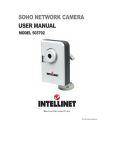

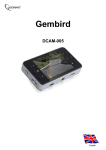
![Internet Camera - [ [ [ ANSEL ] ] ]](http://vs1.manualzilla.com/store/data/005837536_1-ce302c6b28431aa03d9b92e65549b72a-150x150.png)
